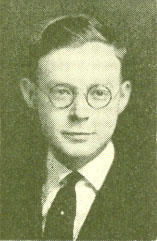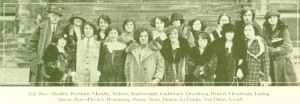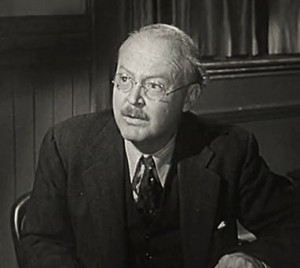By: Sydney Vollmer
The Fresh Painters Club was home to many successful people other than Libby Holman. Lesser known than Holman, her classmate, Don Beddoe, went on to receive more credits in films and television than many established actor today can hope to achieve. Beddoe graduated the University of Cincinnati in 1924 with a Liberal Arts degree. During his time here, he was involved in many extra-curriculars. There are simply so many that it is easier to list them by year. They are as follows:
Freshman: University News, YMCA, Manager freshman track team, Thoms scholar, Lambda Chi Alpha
Sophomore: University News, Assistant Track Manager, YMCA, Cabinet, Aspirants*, Lambda Chi Alpha
Junior: Athletic Editor University News, Manager Track Team, “C”*, Stadium Committee, Mummers, Cincinnatian, Lambda Chi Alpha
Senior: Managing Editor University News, Chairman YMCA Publicity committee, YMCA Cabinet, French Club, Mummers, Musical Comedy, Athletic Editor Cincinnatian, Student Assistant in English, “C” Club, Lambda Chi Alpha, Scroll
*Aspirants- A literary society of for underclassmen publishing “The New Scribe,”a collection of short stories, poems and essays written by students.
*”C”- Club of men that have won varsity letters in athletics.
Looking at the various hats he wore here on campus, one can easily see that he was heavily invested in writing and journalism. In fact, that was his chosen path in life. For some reason (It may well have been his involvement with the Fresh Painters Club) he took an interest in theatre. His father, Dan Beddoe was a renowned tenor and teacher at the College Conservatory of Music, so it’s hardly a surprise that Beddoe fell in love with the stage as well.
After college, he became involved in multiple small productions. In 1929, he made his Broadway debut in Nigger Rich—a production in which he received top billing. It’s worth note that a young Spencer Tracy also appeared in this production. After performing onstage for years, Beddoe made a transition to film. He was certainly never an A-lister, but he appeared next to many of them in his over 300 credits that can be seen on IMDb. Some included Cary Grant, Shirley Temple, Doris Day, Elizabeth Montgomery, and Shelley Winters. Beddoe’s first credited role in a feature was playing the character “Johnson” in There’s That Woman Again (1939). Most of his roles were bit-parts. He would make recurring appearances on shows such as The Lone Ranger, The Loretta Young Show, Perry Mason, Lassie, and Nanny and the Professor to name a few. Some of his more notable feature film credits include playing Walt Spoon in The Night of the Hunter (1955), Mr. Cameron in The Best Years of Our Lives (1946), and Joey in The Bachelor and the Bobby-Soxer (1947). Beddoe continued acting until 1984. His final role was as Kris in an episode of Highway to Heaven.
 Beddoe was married twice. First in 1943 at the age of 40 he married a woman named Evelyn. That marriage lasted until her death in 1974. That same year, Beddoe married again. His new wife was actress and performer Joyce Mathews. He was her fourth husband, preceded by Juan Vincent Gomez (who her mother coerced her into marrying at age 15), actor Milton Berle (married, divorced, remarried, re-divorced), and Billy Rose (also married to him twice). For some reason, Beddoes marriage to Mathews stuck. The pair stayed together until his death in 1991 at age 87.
Beddoe was married twice. First in 1943 at the age of 40 he married a woman named Evelyn. That marriage lasted until her death in 1974. That same year, Beddoe married again. His new wife was actress and performer Joyce Mathews. He was her fourth husband, preceded by Juan Vincent Gomez (who her mother coerced her into marrying at age 15), actor Milton Berle (married, divorced, remarried, re-divorced), and Billy Rose (also married to him twice). For some reason, Beddoes marriage to Mathews stuck. The pair stayed together until his death in 1991 at age 87.
You probably never heard the name “Don Beddoe” before today, but it’s more than likely that you saw his face at least once in some show or film if you were alive before 1984. If you would like to learn more about the Fresh Painters Club or who was involved with it, please make an appointment to come see us and we’ll let you look through the whole collection. Call us at 513.556.1959, email us at archives@ucmail.uc.edu, stop in and see us on the 8th floor of Blegen Library between 8:00 and 5:00, Monday through Friday. Find us on the web at www.libraries.uc.edu/arb.html or follow us on Facebook at www.facebook.com/ArchivesRareBooksLibraryUniversityOfCincinnati/.
Sources:
- http://www.imdb.com/name/nm0558659/bio
- http://www.findagrave.com/cgi-bin/fg.cgi?page=gr&GRid=118390784
- https://en.wikipedia.org/wiki/Dan_Beddoe
- http://www.imdb.com/name/nm0065975/?ref_=nmbio_bio_nm
- https://en.wikipedia.org/wiki/Don_Beddoe


